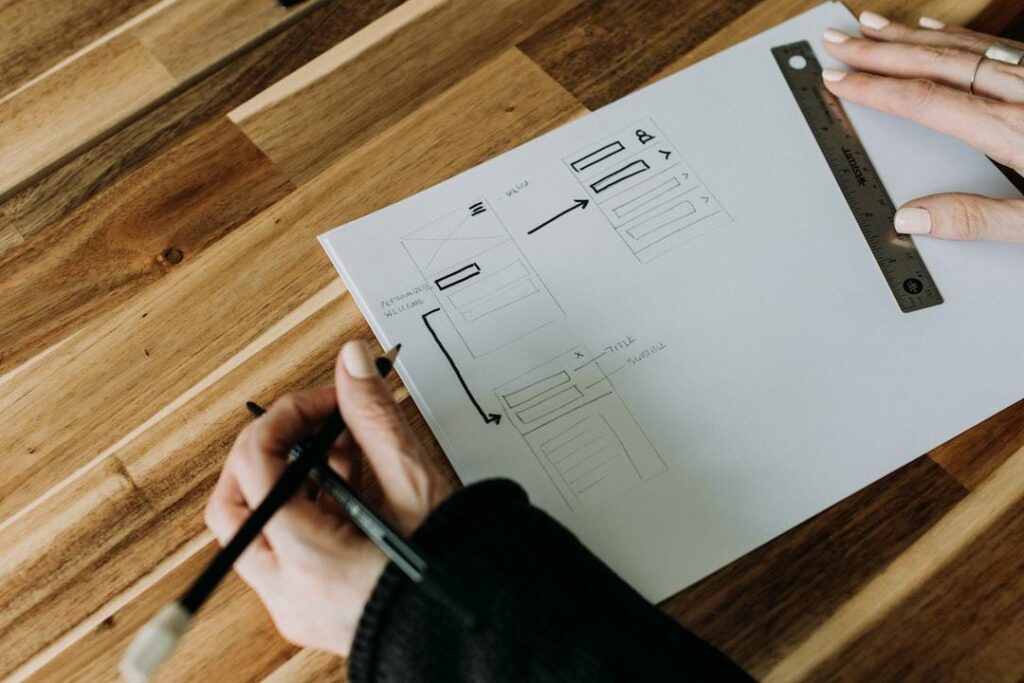Ever tried to organize a chaotic closet? Think of Grids A Startups as your virtual organizing tool in the world of design. They’re like invisible shelves, hanging rods, and drawer organizers that help you neatly arrange everything.
Pictures, text boxes, headlines – all find their rightful place within this structure. It’s the silent puppeteer controlling where each element goes on your screen or page.
Should you’ve ever found yourself marveling, somewhat astonishingly, at the ease with which your eyes glided across the content on certain websites, instead of feeling disoriented and perplexed, like you may have experienced on other sites – well folks, this precisely, is a testament to the captivating effect of grid magic at work!
Intrigued? I thought so! Let’s embark together on this journey through the maze of column grids to manuscript ones and discover why they are every designer’s secret weapon.
Table of Contents:
- Understanding Grids in Design
- A Look at Grid Systems in Graphic Design
- Grids Laying Out Your Web Canvas
- Importance of Grids in UX/UI Design
- Exploring Different Types of Grids
- The Versatility of Column Grids
- Modular Grids for Enhanced Flexibility
- Hierarchical Grids for Organizing Information
- Manuscript Grids for Print Design
- Elements that Make Up a Grid Structure
- Intersecting Lines for Effective Layout Decisions
- Practical Application of Grids
- Usability Testing and Grid Layouts
- The Role of Responsive Grids in Design
- Adapting Grids to Different Screen Sizes
- Nailing Mobile Design With Responsive Grids
- Interplay Between Grids and Typography
- Grids for Text-Heavy Designs
- Making Type Size Work With Grid Systems
- Balancing Alignment Through Baseline Grid Use
- Visual Elements and Their Alignment With Grids
- The Impact of Grids on Visual Balance
- Using Grids for Image Placement and Cropping
- Incorporating Grids in Infographic Design
- Incorporating Grid Systems into Design Projects
- Grid Exploration as a Tool for Design Thinking
- The Role Of The Golden Ratio In Grids
- Tackling Different Screen Sizes With Responsive Grids
- Interplay Between Grids And Typography
- Tried-and-Tested Tips and Best Practices
- The Power of Practice and Experimentation With Grids
- Common Mistakes in Grid Design: Learn From Them.
- Incorporating Best Practices in Your Design Process
- FAQs in Relation to What Are Grids
- What is a grid used for?
- What are the 4 types of grids?
- What is called grid?
- What are examples of grids?
- Conclusion
Understanding Grids A Startups in Design
Design is an intriguing journey, and one of the significant paths to traverse involves grids. But what exactly are grids? They’re more than just intersecting lines on a page; they create a structure that brings order and consistency to your design.
The role of grids extends beyond mere aesthetics. It delves into usability by creating harmony between visual elements, aiding readability, and improving user experience. Let’s explore how grids can be beneficial in graphic design.

A Look at Grid Systems in Graphic Design
In graphic design projects, a well-executed grid system can be your best friend. Imagine it as invisible scaffolding holding up your artwork—creating balance and guiding viewers’ eyes across the layout effortlessly.
You might ask why we need such invisible guides? The answer lies within human behavior patterns themselves – our brains crave organization. This means designs based on sound grid structures inherently feel ‘right’ because they align with our innate preference for orderly information presentation. Just Enough Research offers some great insights into these concepts if you want to delve deeper.
Grids Laying Out Your Web Canvas
Moving from print media towards web layouts isn’t just about swapping tools or mediums—it’s also about adjusting principles. Here’s where the concept of responsive grids comes into play: unlike fixed-size paper pages used in traditional graphic design, screen sizes vary drastically when designing for the web.
To tackle this diversity effectively without compromising quality or usability requires practice—and lots of it. But once mastered—the ability to use responsive grid systems unlocks new possibilities for accommodating diverse viewing environments—from large desktop monitors to small mobile screens.
Importance of Grids in UX/UI Design
Using grids for UX/UI design is not only important as an organizational tool, but also helps create a cohesive narrative throughout the user experience. Here, a grid isn’t just an organizational tool; it becomes part of your storytelling process, helping create a coherent narrative throughout the user journey.
By smartly using a grid system, you can seriously boost how user-friendly your design is.
Key Thought:
Grids in design aren’t just about lines crossing on a page, they’re the unseen structure that brings balance and consistency to your work. In graphic design, grids help create designs that feel ‘right’ due to our brain’s preference for order. Moving into web layouts introduces responsive grid systems which allow you to adapt to varying screen sizes without losing quality or usability.
Exploring Different Types of Grids
The world of design is as diverse as the array of grids that we use to create compelling visuals. Let’s delve into some common types: column, modular, baseline, hierarchical, and manuscript grids.
The Versatility of Column Grids
Column grids are like the dependable friend you can always count on – simple yet versatile. They help structure content horizontally across a layout in an organized manner.
If you’re working on a magazine spread or website layout where text needs to flow smoothly from one column to another, this grid type could be your go-to buddy.
Modular Grids for Enhanced Flexibility
Akin to Lego blocks stacked together neatly in rows and columns, modular grids offer creative flexibility by dividing space into multiple consistent units. These modules govern how elements such as images and text sit within the layout.
This type adds an extra layer of control over designs compared with our old pal column grid; it allows designers to play around more with different-sized components while maintaining harmony across their workpiece.
Hierarchical Grids for Organizing Information
In need of hierarchy? The hierarchical grid comes armed with its superpower – prioritization. It helps establish clear visual relationships between various elements based on importance. Whether it’s designing web interfaces or print materials – think book layouts or event posters – they come in handy when information has varying levels of significance.
Note: All these grid systems aim at enhancing user experience through efficient organization & aesthetic appeal – so don’t shy away from experimenting.
Manuscript Grids for Print Design
The manuscript grid is the OG of grids. Think about ruled paper in school – that’s essentially a basic form of this type. With its roots deep in print design, it’s particularly effective when dealing with large blocks of text.
For books and other text-rich materials, this classic style shines by ensuring a consistent feel throughout.
Key Thought:
Grids are a designer’s secret weapon, offering diverse ways to organize and enhance visual content. Column grids simplify structuring content horizontally, while modular grids add flexibility with consistent units. Hierarchical grids prioritize elements based on importance, and manuscript grids excel in handling large text blocks. So go ahead – experiment away.
Elements that Make Up a Grid Structure
Design is not merely the visible components like colors, forms, and typefaces; it encompasses more than what can be seen. It’s more than meets the eye – it’s all about structure too. The foundation of this structure often lies in grids.

Intersecting Lines for Effective Layout Decisions
A grid is like an invisible scaffolding that helps to organize elements on your design canvas. This system involves two key components: columns and rows, which form intersecting lines. These intersections serve as guides where you can place text or images.
Incorporating a grid into your layout decisions might seem simple but there are some tricks to doing it effectively. First off, consider how adding rows or creating modules with columns could benefit your design project. For instance, if you’re designing a magazine spread with several articles on one page, using multiple rows could help distinguish between each story.
Canva’s guide provides useful insights into making these effective layout decisions by leveraging intersecting lines within grids.
If you’re wondering how these guidelines work in practice let me give you an example from my own experience working on Design Match projects. Let’s say we have four equally important topics to cover on our webpage; we’d divide our row into four equal columns – essentially creating ‘homes’ for each topic.
The column approach isn’t limited only to textual content though. In visual designs too – such as infographics or photo galleries – they offer great assistance (oops… I mean ‘help’) in arranging items symmetrically and pleasingly.
Pitfalls To Avoid When Adding Rows & Creating Modules With Columns
- You don’t want things looking squashed together nor do you want excessive space. So, it’s a good practice to leave some ‘breathing room’ around your elements.
- Keep in mind the overall balance of your design. Too many rows or columns might make the design look cluttered and complicated.
- The number of columns should correspond with the amount of information you need to display – not more, not less.
Looking for grids that adjust smoothly across different screen sizes for the best user experience? Go responsive.
Key Thought:
Design goes beyond just color and typeface, it’s also about layout. Grids offer this unseen structure with their cross-hatching of columns and rows, guiding you in arranging elements on your canvas. They’re not just for text – they excel at organizing visuals too. But don’t forget: keep the space balanced, neither squashed nor stretched out too much, aligning to columns properly.
Practical Application of Grids
The magic of design lies in the practical application of grids. This system, though seemingly invisible, plays a key role in defining the structure and orderliness within user interface (UI) and visual designs.
Usability Testing and Grid Layouts
Grid layouts serve as an essential tool for usability testing. Their presence ensures consistency across different elements on a page, making it more predictable for users to interact with.
A well-structured grid layout helps create clear paths for eye movement while also providing guides where to place text or other graphic elements effectively. All these contribute towards creating a pleasant user experience that leads to increased engagement rates.
Incorporating grids into your design process can make your projects easier to manage while maintaining high-quality outputs consistently. They give you a framework that lets you balance creativity with logic – giving each element its proper place without compromising aesthetic appeal. Just Enough Research, an insightful book by Erika Hall provides some fascinating insights into this aspect of UI design using grid systems.
An interesting study shows how adopting responsive grid systems helped increase conversion rates on web pages by up 27%. This stat emphasizes the power held by effective use of grids in enhancing user experience and achieving business goals concurrently.
Making Use Of Standard Grid Systems In Design Projects
A common type used often is the standard 12-column grid which offers great flexibility due to its ability to easily divide sections equally. However, don’t be afraid to experiment with adding rows or modifying column widths when needed; remember every project has unique requirements. For instance, let’s take print-based projects such as magazines or books – here manuscript grids could prove to be more beneficial due to their simplicity and focus on text.
Another example would be when designing a responsive website. Here, your grid needs to adapt based on different screen sizes without losing the core layout’s essence. For such cases, using responsive grids could prove beneficial as they help maintain consistency across various devices while ensuring optimum usability.
Ensuring Consistency With Grid Systems
Keeping things consistent is crucial when you’re working on design projects. Maintaining consistency not only enhances the user experience, but also provides a more unified visual appeal.
Key Thought:
Grids are like the secret ingredient in design, giving shape to UI and visuals while offering structure. They’re key for user-friendly testing and consistency, leading users predictably through interactions. A well-crafted grid controls eye movement and arranges text or graphics effectively—it strikes a balance between creativity and logic without losing its visual appeal. Remember, experimentation is crucial: while the standard 12-column grids give you flexibility, don’t hesitate to mix things up.
The Role of Responsive Grids in Design
Grasping the concept of responsive grids can feel like trying to catch a fish with your bare hands. It’s slippery, elusive, and you’re bound to get wet. Once you’ve mastered it, responsive grids will be a powerful asset in your design arsenal.
Unlock the enigma of ‘responsive’ – a flexible structure that alters its design depending on screen size. A responsive grid system is a flexible framework that adapts layouts according to different screen sizes. Imagine playing Tetris but the blocks automatically rearrange themselves into perfect harmony regardless of the size or shape of the game board – pretty cool right?
Adapting Grids to Different Screen Sizes
It can be really annoying when websites don’t show up properly on our gadgets. That adorable cat video looks less cute when cut off at the whiskers. Here’s where responsive grids come riding in like knights in shining armor. They ensure elements are correctly aligned and displayed across multiple screen sizes without compromising aesthetics or usability.
According to stats from Pew Research Center, 96% of Americans own a cellphone with nearly three-quarters owning desktop/laptop computers. So there’s no denying – designing for various screen dimensions is essential.
Nailing Mobile Design With Responsive Grids
You might think creating designs tailored for mobile sounds as complex as teaching your grandma TikTok dances… But trust me; it doesn’t have to be so tricky.
The key lies within these magical little things called grids. They allow for fluid layouts that automatically adapt to the device’s screen size, whether it be a pocket-sized smartphone or a mammoth desktop monitor.
Ready for the cherry on top? After setting up your grid, you’ll likely see a big boost in conversions. Smashing Magazine points out that responsive grids can simplify navigation and elevate user experience.
Key Thought:
Responsive grids are like magic tools in design, making your layouts adapt smoothly to different screen sizes. This isn’t just cool—it’s crucial, given how many of us use various devices daily. By using responsive grids for mobile-friendly designs, you can improve user experience and even boost conversions.
Interplay Between Grids and Typography
The interplay between grids and typography is akin to a well-choreographed dance. Both elements work in tandem, creating designs that are not only visually appealing but also easily navigable. Let’s delve into how these two components interact with each other.
Grids for Text-Heavy Designs
When dealing with text-heavy designs, grids can be the saving grace you need. By using grid systems like baseline grids, we create consistent alignment of our type size across the design canvas.
This method allows us to structure large chunks of information effectively while maintaining readability. It’s similar to setting up invisible ruled paper where every line perfectly aligns your text.
A Smashing Magazine article further emphasizes this concept by stating how column grids help place text within a layout seamlessly – as if they were designed together from inception.
The relationship between vertical fields created by intersecting rows and columns plays an integral role too. They define areas where textual content can sit comfortably without disrupting overall visual harmony.
Making Type Size Work With Grid Systems
Type size matters significantly when working with grid structures in design projects; it’s no less important than knowing your ABCs. Just imagine trying to read tiny font on an enormous billboard – it simply wouldn’t make sense.
Incorporating the golden ratio helps here because larger type sizes naturally demand more space on your grid layout compared to smaller ones. The challenge lies in finding balance so that both small and big fonts coexist harmoniously within the same grid system.
Balancing Alignment Through Baseline Grid Use
Alignment is the invisible thread that holds design elements together. When it comes to text, baseline grids ensure consistent alignment across all content areas – from headlines and body copy right down to footnotes.
Think of it as a quiet maestro making sure each line, like an instrument in the orchestra, hits its note at just the right moment. If elements don’t align accurately, it could leave viewers perplexed.
Key Thought:
Grids and typography perform a dance in design, working together to create visually pleasing and easily navigable content. With text-heavy designs, grids provide consistency across the canvas. Balancing type size within grid structures is crucial for readability, with alignment being achieved through baseline grids. This combo ensures your ‘design orchestra’ plays harmoniously.
Visual Elements and Their Alignment With Grids
Grid systems play a crucial role in the alignment of visual elements. Whether it’s images, logos, or infographics – grids can make sure they all find their right place.
A well-implemented grid system helps create visually balanced design layouts that are pleasing to the eye. It’s like a rulebook for your content placement, ensuring harmony between different graphic elements on your page.

The Impact of Grids on Visual Balance
The impact of grids on visual balance is often underestimated. Using grids properly can make a huge impact on the visual balance of your design, as it requires careful consideration of each element’s importance and its relation to other components in the layout.
You see, balancing visual weight within a layout isn’t as easy as evenly distributing objects across the screen size. It involves careful consideration of each element’s importance and its relation to other components within the layout design. Just Enough Research suggests considering factors such as color intensity and size while assigning positions with grid overlay guidance.
If an image has high saturation or complexity compared to others, it might be best placed at strategic points along grid lines instead of haphazardly anywhere around text sit zones in the user interface. With these considerations made easier by incorporating responsive grid systems into your workflow process during usability testing stages can save time adjusting alignments later down line.
Using Grids for Image Placement and Cropping
We’ve all been there: trying to crop an image so that it fits perfectly within our design project but somehow just not getting it quite right? That’s where grids come into play. They provide clear guidelines which help ensure consistency across multiple projects making life easier for everyone involved.
For instance, using a column grid can guide your image placement and cropping decisions. The grid structure provides visual cues on where to place your images and how much space they should occupy in relation to other design elements. Plus, with responsive grids at hand – you’re well-equipped to tackle varying screen sizes too.
Incorporating Grids in Infographic Design
Infographics take the importance of grids up a notch due to their heavy info content. You’re dealing with data points and charts sprinkled everywhere.
Key Thought:
Grids are like your design’s secret rulebook, ensuring every visual element finds its perfect place. They bring balance to your layout by considering factors like color intensity and size. From image placement to cropping, grids make sure consistency is king across all projects. And with infographics? Grids are a game-changer for handling heavy info content.
Incorporating Grid Systems into Design Projects
Grid systems can be a game-changer for your design projects. They help create structure, consistency, and harmony in layouts.
The importance of having a clear grid idea cannot be overstated. Like the foundation of a building, it forms the backbone upon which your designs stand strong.
Grid Exploration as a Tool for Design Thinking
Spend time exploring different types of grid structures during the initial stages of your design process. This exploration is like playing with LEGO blocks – experimenting with various combinations to build something unique and beautiful.
User interviews are another key aspect that could influence grid decision-making. Incorporating user feedback can be invaluable when attempting to address a particular issue. Involving users early on gives us insights we may not have considered otherwise.
Just Enough Research, an excellent resource by Erika Hall, offers more guidance on how user research plays into effective design decisions.
The Role Of The Golden Ratio In Grids
Have you ever looked at sunflowers or seashells and wondered why they’re so pleasing to look at? It’s because they follow what’s called the golden ratio – approximately 1:1.61803398875 (give or take). Just like nature, if our designs adhere to this ratio, there’s a greater chance people will find them visually appealing.
Tackling Different Screen Sizes With Responsive Grids
“A good designer knows how to work within constraints.”
Responsive grids are one such constraint designers should embrace. By adapting grids according to different screen sizes, we ensure no matter where our content appears—desktop computers or mobile phones—it’s easy to read and navigate.
Interplay Between Grids And Typography
The utility of a grid arrangement competently made is its multifaceted nature. It can work hand-in-hand with typography, guiding the placement and alignment of text within designs. Think about it as creating invisible lines that guide your reader’s eyes from one point to another on your design canvas.
When you’re tackling designs loaded with text, baseline grids become your best friend.
Key Thought:
Grid systems form the foundation of your design projects, providing balance and order. Think of it as building with LEGO – start experimenting with different grid structures from the get-go. Gather feedback from users to make savvy choices about grids. Keep in mind that nature loves the golden ratio (1:1.61803398875), so if your designs follow suit, they’re likely to look good too. Don’t forget to use responsive grids.
Tried-and-Tested Tips and Best Practices
Designing with grids is not just about putting things in boxes. It’s a science that involves experimentation, understanding common mistakes, and incorporating best practices to get the most out of your design project.
The Power of Practice and Experimentation With Grids
Diving into grid designs means trying new techniques. Start by experimenting with different types of grids like column or modular ones. This practice helps you understand how each type impacts your layout decisions and visual balance.
A great place for beginners to start this exploration journey is Canva’s guide on grid designs. Here you’ll find various exercises designed to let your creativity flow while also helping you learn the ropes of effective grid usage.
Common Mistakes in Grid Design: Learn From Them.
Mistakes are part of any learning process – they’re stepping stones towards mastering a skill. When it comes to designing with grids, some errors are more common than others:
- Ignoring Margins: Remember, margins aren’t just space fillers – they create breathing room around content elements making them easy on eyes.
- Inconsistent Usage: Using varying types or sizes within one design can confuse users; maintaining consistency ensures smoother user experience (UX).
- Lack Of Responsiveness: In today’s digital world where screen sizes vary drastically across devices, failing to use responsive grids might make layouts look distorted on certain screens.
To help avoid these pitfalls from the get-go take time reading through Smashing Magazine’s comprehensive article “Building Better UI Designs With Layout Grids.”
Incorporating Best Practices in Your Design Process
No single approach is suitable for all when it comes to utilizing grids; however, certain best practices have been proven effective over time. But some best practices have stood the test of time:
- All About the User: When it comes to UX/UI design, we’ve got to focus on what users need and how they behave;
Key Thought:
Grid design isn’t about boxing things in, it’s a creative science that needs practice and understanding. Experiment with different grid types like column or modular to see their impact on your layout. Avoid common mistakes such as ignoring margins, inconsistent usage and lack of responsiveness. And remember: the user is king – make sure their needs are at the heart of your designs.
FAQs in Relation to What Are Grids
What is a grid used for?
Grids are key tools in design. They lend structure, guide the layout, align elements, and foster consistency across different screens.
What are the 4 types of grids?
The four main types of grids are manuscript, columnar, modular, and hierarchical. Each offers unique advantages for different designs.
What is called grid?
A ‘grid’ refers to a framework made up of intersecting lines which helps organize content in design layouts.
What are examples of grids?
You see grids everywhere. Newspapers use columnar grids; websites employ responsive ones; books leverage manuscript style while infographics may utilize modular ones.
Conclusion
Mastering the maze of design just got easier with our exploration into what are grids.
We’ve delved deep into their types, from column to manuscript. We’ve discovered how they enhance flexibility and creativity.
We’ve learned about their structure, including columns, rows, and intersecting lines that govern layout decisions.
The impact of grid systems on visual balance? We now know it’s undeniable! From text-heavy designs to aligning graphic elements – grids have a role everywhere.
To wrap up: Grids aren’t merely tools for organizing chaos in design; they’re also silent guides leading users’ eyes through your content effortlessly. So get creative with them!




